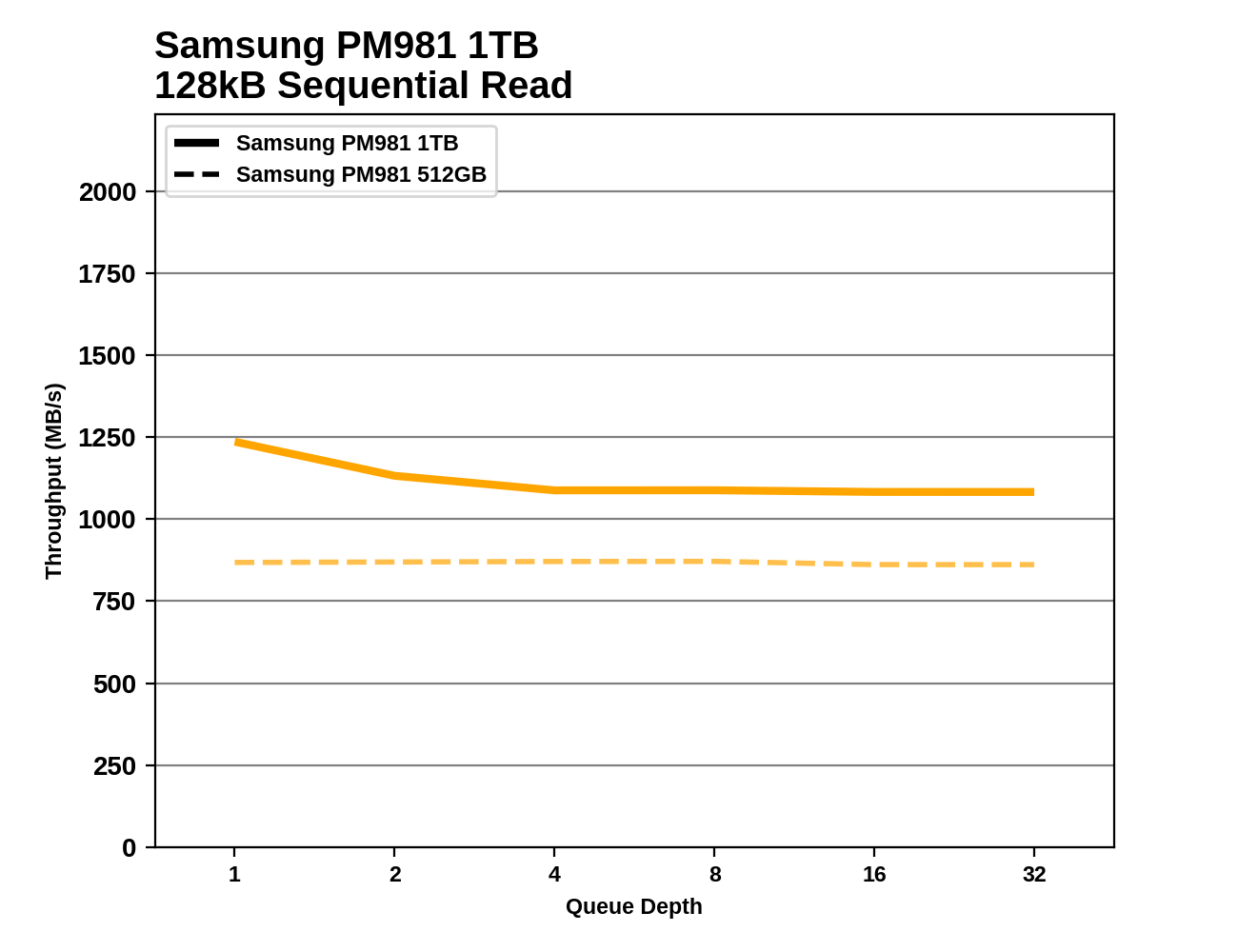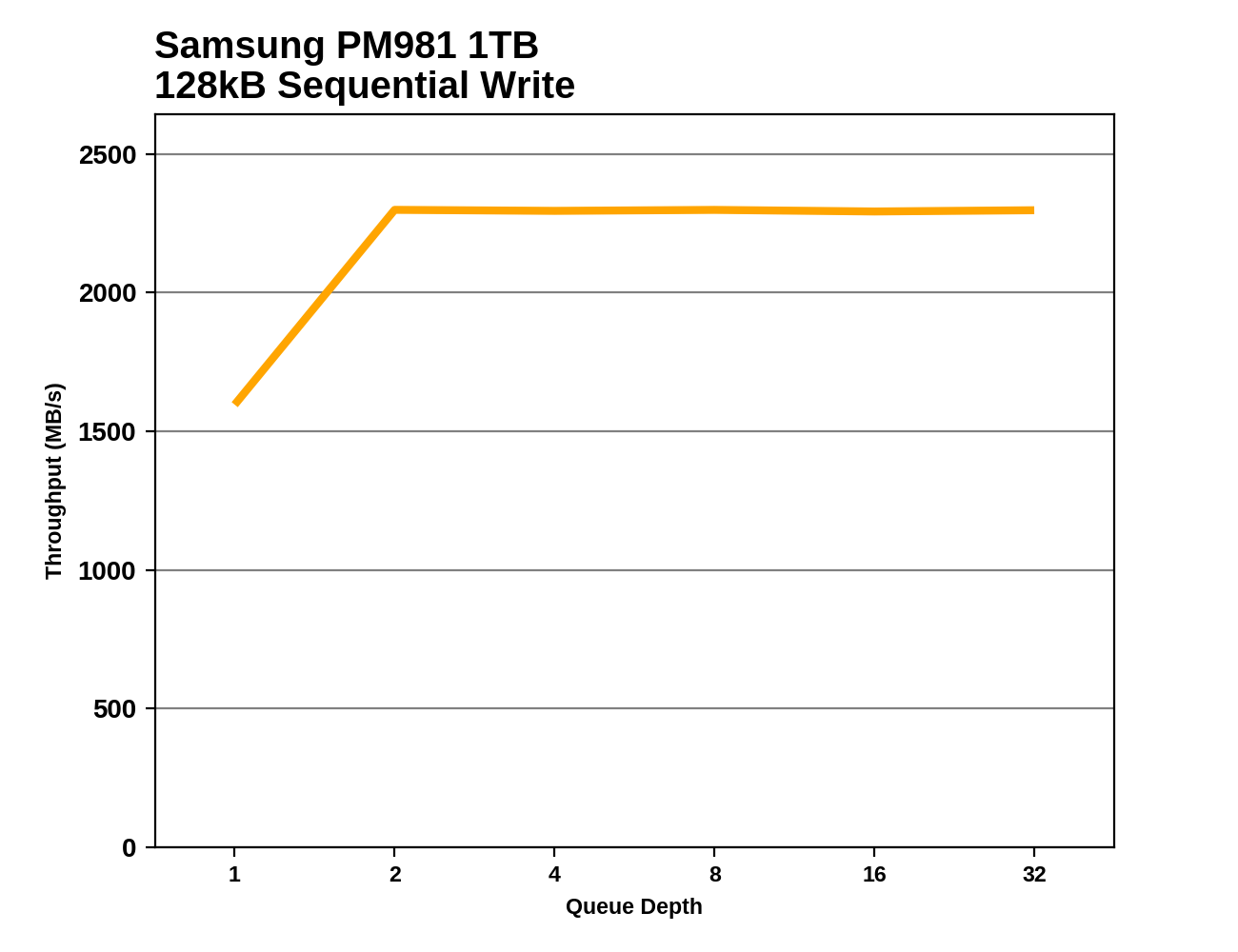The Samsung PM981 SSD Review (512GB, 1TB): Next Generation Controller And 3D NAND
by Billy Tallis on November 30, 2017 9:02 AM ESTSequential Read Performance
Our first test of sequential read performance uses short bursts of 128MB, issued as 128kB operations with no queuing. The test averages performance across eight bursts for a total of 1GB of data transferred from a drive containing 16GB of data. Between each burst the drive is given enough idle time to keep the overall duty cycle at 20%.

The burst sequential read performance of the Samsung PM981 doesn't quite set a new record, but it's pretty close to the top performer and very far ahead of any non-Samsung drive.
Our test of sustained sequential reads uses queue depths from 1 to 32, with the performance and power scores computed as the average of QD1, QD2 and QD4. Each queue depth is tested for up to one minute or 32GB transferred, from a drive containing 64GB of data.

On the longer test with higher queue depths, the best MLC-based drives pull ahead of the PM981 and even the 960 EVO has a slight advantage.
 |
|||||||||
The 1TB PM981 starts out with almost the same performance as the 1TB 960 EVO, but the PM981's performance falls off a bit during the first half of the test while the 960 EVO remains steady. The 512GB PM981 doesn't experience any slowdown, but it is slower than the 1TB model throughout the test.
Sequential Write Performance
Our test of sequential write burst performance is structured identically to the sequential read burst performance test save for the direction of the data transfer. Each burst writes 128MB as 128kB operations issued at QD1, for a total of 1GB of data written to a drive containing 16GB of data.

The PM981s both deliver the same record-setting burst sequential write performance that is a marked improvement over the best of Samsung's last generation, and far ahead of any competing flash-based SSD.
Our test of sustained sequential writes is structured identically to our sustained sequential read test, save for the direction of the data transfers. Queue depths range from 1 to 32 and each queue depth is tested for up to one minute or 32GB, followed by up to one minute of idle time for the drive to cool off and perform garbage collection. The test is confined to a 64GB span of the drive.

On the longer sequential write test, the 512GB PM981 falls behind most of the rest of the Samsung drives but the 1TB model remains on top, ahead of even the 960 PROs.
 |
|||||||||
The 1TB PM981 hits full write speed at QD2 and stays there for the rest of the test, holding on to its lead over the 960 PRO. The 512GB PM981 runs out of SLC write cache early on and its performance bounces around with the garbage collection cycles.










53 Comments
View All Comments
peevee - Thursday, November 30, 2017 - link
The most important parameter is the sustained random read, when the user have to actually wait (buffered writes let you continue working right away and it is almost impossible to overflow write caches during normal desktop usage).And even SSDs continue to suck in this parameter. 60MB/s? Booo...
Although testing on 4k random is too strict, NTFS runs are usually 16 clusters (64k).
wyewye - Thursday, November 30, 2017 - link
This is why I stopped coming to Anandtech daily: you keep excluding top offers from Intel in your SSD benchmarks.Samsung shills!
ddriver - Thursday, November 30, 2017 - link
LOL, second funniest thing I heard this weekddrіver - Thursday, November 30, 2017 - link
The first one was actually a joke with a priest and a rabbi... Can't really remember the punchline now.lilmoe - Thursday, November 30, 2017 - link
Thank you, competing OEMs. Thanks to you, Samsung isn't even trying anymore. Just when I thought they'd introduce 64 layer SLC, they decide to go full TLC, because why try harder? Screw you too, Samsung.ddrіver - Thursday, November 30, 2017 - link
Exactly my point. It's not so hard for them to go to 64 or 128 or even 256 layer SLC, with even an 8TB SSD. That should be in the range of $500-$600 to be competitive. Instead they choose to deliver a drive that simply doesn't massively improve on every single data point relative to the old generation. It might be good for 95% of consumers but they don't even think of us, professionals.Just downloading a game nowadays takes 50-100GB of SSD writes. At this rate who know how long I'm going to be able to use this kind of SSD. Greedy people selling to sheeple. Wake up!
zodiacfml - Friday, December 1, 2017 - link
Samsung, like Intel, has no competition taking their sweet time with each iteration.AnnonymousCoward - Saturday, December 2, 2017 - link
In many cases Samsung costs more and has less endurance; the competition is better.melgross - Friday, December 1, 2017 - link
It’s good to see that manufacturers are so far in advance of where they already are:“Other M.2 PCIe SSD vendors have used that tactic and many have also released drives with more substantial heatspreaders or heatsinks in the future.”
trumanhw - Sunday, December 31, 2017 - link
1TB 960 Pro looks like it's the shiznit. By far my choice... cost per dollar, and as they said, impunity to the negatives seen in other sizes and models. Where it's not the first, it's so close in the other positions as to require measurement to verify. As always, thank you anand -- you guys rock.